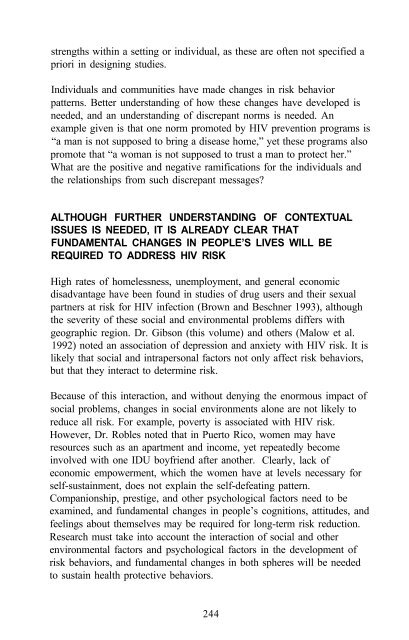The Context of HIV Risk Among Drug Users and Their Sexual Partners
The Context of HIV Risk Among Drug Users and Their Sexual Partners
The Context of HIV Risk Among Drug Users and Their Sexual Partners
Create successful ePaper yourself
Turn your PDF publications into a flip-book with our unique Google optimized e-Paper software.
strengths within a setting or individual, as these are <strong>of</strong>ten not specified a<br />
priori in designing studies.<br />
Individuals <strong>and</strong> communities have made changes in risk behavior<br />
patterns. Better underst<strong>and</strong>ing <strong>of</strong> how these changes have developed is<br />
needed, <strong>and</strong> an underst<strong>and</strong>ing <strong>of</strong> discrepant norms is needed. An<br />
example given is that one norm promoted by <strong>HIV</strong> prevention programs is<br />
“a man is not supposed to bring a disease home,” yet these programs also<br />
promote that “a woman is not supposed to trust a man to protect her.”<br />
What are the positive <strong>and</strong> negative ramifications for the individuals <strong>and</strong><br />
the relationships from such discrepant messages?<br />
ALTHOUGH FURTHER UNDERSTANDING OF CONTEXTUAL<br />
ISSUES IS NEEDED, IT IS ALREADY CLEAR THAT<br />
FUNDAMENTAL CHANGES IN PEOPLE’S LIVES WILL BE<br />
REQUIRED TO ADDRESS <strong>HIV</strong> RISK<br />
High rates <strong>of</strong> homelessness, unemployment, <strong>and</strong> general economic<br />
disadvantage have been found in studies <strong>of</strong> drug users <strong>and</strong> their sexual<br />
partners at risk for <strong>HIV</strong> infection (Brown <strong>and</strong> Beschner 1993), although<br />
the severity <strong>of</strong> these social <strong>and</strong> environmental problems differs with<br />
geographic region. Dr. Gibson (this volume) <strong>and</strong> others (Malow et al.<br />
1992) noted an association <strong>of</strong> depression <strong>and</strong> anxiety with <strong>HIV</strong> risk. It is<br />
likely that social <strong>and</strong> intrapersonal factors not only affect risk behaviors,<br />
but that they interact to determine risk.<br />
Because <strong>of</strong> this interaction, <strong>and</strong> without denying the enormous impact <strong>of</strong><br />
social problems, changes in social environments alone are not likely to<br />
reduce all risk. For example, poverty is associated with <strong>HIV</strong> risk.<br />
However, Dr. Robles noted that in Puerto Rico, women may have<br />
resources such as an apartment <strong>and</strong> income, yet repeatedly become<br />
involved with one IDU boyfriend after another. Clearly, lack <strong>of</strong><br />
economic empowerment, which the women have at levels necessary for<br />
self-sustainment, does not explain the self-defeating pattern.<br />
Companionship, prestige, <strong>and</strong> other psychological factors need to be<br />
examined, <strong>and</strong> fundamental changes in people’s cognitions, attitudes, <strong>and</strong><br />
feelings about themselves may be required for long-term risk reduction.<br />
Research must take into account the interaction <strong>of</strong> social <strong>and</strong> other<br />
environmental factors <strong>and</strong> psychological factors in the development <strong>of</strong><br />
risk behaviors, <strong>and</strong> fundamental changes in both spheres will be needed<br />
to sustain health protective behaviors.<br />
244
















